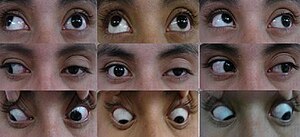Recurrent painful ophthalmoplegic neuropathy
[4][5] Although the etiology of RPON is unknown owing to the rarity of this disease, various potential theories including migrainous and neuropathic mechanisms have been developed.
[8] Despite the fact that there are currently no evidence-based treatment guidelines for RPON, the most commonly used medications are corticosteroids that have been proven effective in alleviating the symptoms.
[9][10][11] RPON has a good overall prognosis as a result of the self-limiting nature of the condition, but permanent neurological damage may accumulate over repeated episodes.
[11] The typical symptoms of RPON are recurrent headaches and ipsilateral paralysis of the extraocular muscles (ophthalmoplegia) that are responsible for controlling eye movements.
[1] People with RPON experience different severity of pain, duration of symptoms, and frequency of attacks, which are also dependent on the treatment they received.
[11] Pupil dilation (mydriasis) and reduction in pupillary light reflexes can also be observed as pupillomotor fibers are also affected by CNIII paralysis.
[22] However, cerebrospinal fluid (CSF) analyses are normal in the vast majority of RPON cases, which is inconsistent with the findings of autoimmune or inflammatory-mediated pathomechanism.
[13][22] Inflammatory demyelination of the ocular cranial nerves would likely lead to the release of neuropeptides, such as calcitonin gene-related peptide, to the trigeminovascular system.
The transient, reversible enhancement or thickening of the ocular motor nerve(s), which can be observed in the MRI scans of a small proportion of affected individuals during acute attacks, is a distinguishing feature of RPON.
[5] In cases where intracranial vascular lesions, for example, subarachnoid hemorrhage cannot be completely ruled out after performing MRA or CTA, physicians may consider using traditional digital subtraction angiography (DSA) for more detailed investigation.
[5] Since the evaluation of effective treatments is entirely based on evidence from a limited number of case reports, there is some uncertainty surrounding the proposed efficacy of the drugs for treating RPON.
[5][8][12][26] Although the efficacy of these preventives has been proposed in various published case studies, there is a lack of compelling evidence suggesting that these anti-migraine drugs have long-term prophylactic effect on future RPON attacks.
Early implementation of corticosteroid therapy is considered beneficial to the majority (96.2%) of people with RPON because it can shorten their recovery time and reduce the severity of existing symptoms.
[5][8][12][14] Even though various studies have documented the success of using this medication to induce symptomatic relief in affected individuals, the improvement is not as rapid and significant as observed in other inflammatory diseases, such as THS and temporal arteristis.
[12] In addition, some steroid non-responders may have worsened RPON symptoms after taking these drugs, suggesting that corticosteroids are not suitable for treating every patient with the condition.
[5] In more extreme cases, additional intervention such as botulinum toxin injection and strabismus surgery, might be required to rebalance the actions of the extraocular muscles.
[5] Among people with recurrent episodes of RPON, about 30-54% develop permanent neurological sequelae, such as persistent mydriasis, ptosis, strabismus and double vision.

